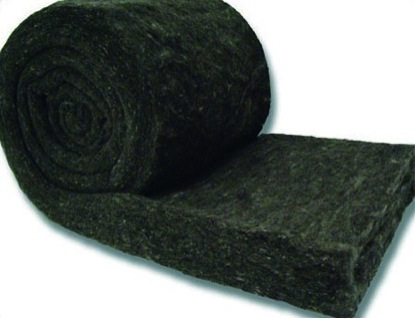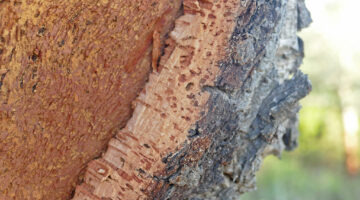
There are 4 different types of wool insulation that you can use to insulate lofts, walls and even floors – each having its own benefits and limitations. In this section we describe each one and highlight when best to to use it.
Remember if your loft has 150mm or less of existing wool insulation you need to increase the thickness up to at least 270 mm, preferably 350 mm. The number of Green Deal customers in London that we see who claim there loft is full of insulation when in fact they only have 100 mm loft insulation in place is staggering!
Sheep’s wool Insulation
Sheep’s wool has allowed sheep to live in even the hardest conditions for thousands of years and for a long time now humans haven taken advantage of its natural insulating properties using it for clothing. The insulating properties of the wool are down to the millions of tiny air pockets between the wool fibres that trap the air, preventing movement of heat across it.
Prior to using sheep’s wool in your loft it needs to be treated with chemicals to remove the oils and dirt from it. It can also be treated with additional chemicals to coat it in a substance that repels rodents.
Features of Sheep’s Wool:
- It is a natural product produced every year by sheep, therefore there are no costs associated with producing it.
- Sheep’s wool has good insulating properties, helping to keep heat in during the winter and heat out during the summer.
- Sheep’s wool insulation is perfectly safe to touch, causing zero irritation, therefore no specialist clothing to install it.
- The wool is very flexible and therefore very easy to install in the home.
- Wool fibre is breathable, naturally absorbing and releasing moisture without decreasing its thermal insulating properties, which has the added benefit of preventing damp build up on wooden joists in the loft.
- Wool does not burn readily in air, since it needs a higher concentration of oxygen to combust than is found naturally in air.
- Sheep’s wool costs about £20/m2 for 200mm+
Limitations
- Although sheep’s wool is produced naturally, since the demand for wool for other uses is relatively high, it is higher in price than either glass or mineral wool.
- The wool needs to be treated with chemicals so it is not 100% energy free to produce (in fact it requires about 15% of the energy required to produce glass or mineral wool).
In our opinion, insulating with sheep wool is definitely the most sustainable (and itch free!) method of insulating your loft or rafters. In an effort to allow you to take the advantage of the benefits of insulating with sheepwool, we now sell sheep wool rich insulation in our energy efficiency store.
Glass wool insulation
Glass wool insulation is perhaps the most commonly used type of insulation installed today. It is made by heating glass and sand to about 15000c causing the mixture to melt. This is then spun at high speed to form fibres, which are then stuck together using a resin binder, creating a thick web of fibres that is highly flexible and resembles sheep’s wool. It is recommended that glass wool insulation is laid to a thickness of 270mm to maximise its insulating properties.
Features of glass wool:
- Glass wool comes in rolls that can simply be unrolled between joists, making it very easy to install.
- It has good insulating properties, helping to keep heat in during the winter and heat out during the summer.
- It is the cheapest of all the insulation products, with rolls available from DIY shops for about £2/m2
- Glass wool insulation also provides good acoustic qualities.
- Glass wool is resistant to fire
- During the manufacture process, about 70-80% of the glass wool is produced from recycled glass
- Glass wool is resistant to insects.
Limitations
- Although some glass wool does not cause skin irritation, most will, so we recommend covering up all of your skin while laying the insulation in your roof.
- You require gaps around down lights and electrical boxes in the loft, which reduces the effectiveness of its insulation properties.
- If the insulation becomes wet, it looses it’s effectiveness.
Mineral wool insulation
Mineral wool (sometimes known as Rockwool) is made from volcanic rock, which is an abundant resource. Like glass wool, the volcanic rock is heated to about 15000C, which causes it to melt. The liquid volcanic rock is then spun at high speeds to produce rock fibres, which is then binded together with a resin and small amounts of oil, creating the mineral wool.
Features of mineral wool:
- Mineral wool has excellent thermal insulation, reducing energy consumption in the winter and helping preventing your home from overheating in the summer.
- Mineral wool comes in rolls that can be unrolled between joists, making it relatively easy to install (not as easy as glass wool).
- Mineral wool has superior fire resistance when compared to glass wool; installing it can actually improve the fire resistance of your property, effectively acting as a fire barrier.
- Mineral wool is about 4 times denser than glass wool, so has better acoustic properties.
- Mineral wool is costs approximately £5/m2
Limitations
- Mineral wool will cause irritation if it comes into contact with bare skin, so we recommend covering up all of your skin while laying the insulation in your loft.
- You require gaps around down lights and electrical boxes in the loft, which reduces the effectiveness of its insulation properties.
Natural hemp insulation
Much like sheep’s wool, hemp insulation is produced from a naturally produced hemp fibres. Hemp is an incredibly versatile crop that has been used for thousands of years to produce rope and clothing, but is now being used to produce biodegradable plastics, fuel and insulation.
Hemp grows to a height of about five metres in only one hundred days, normally requiring very little water and fertilizer and it grows almost anywhere. During growth the hemp crop will sequester (lock up) about two tonnes of carbon dioxide per tonne of fibre harvested, which it uses for growth. This carbon dioxide will not be released until the hemp decomposes at the end of its useful life (which should easily outlive the building’s life).
Like natural sheep’s wool, hemp can breathe, absorbing about 20% of its weight in moisture before there is any negative impact on its insulating properties.
Features of Hemp Insulation:
- It is a natural product produced from the Hemp crop, taking little time to reach maturity and needing very little water to grow.
- Hemp insulation has good insulating properties, helping to keep heat in during the winter and heat out during the summer.
- As it is a plant it sequesters carbon dioxide until it decomposes (when it reaches the end of its useful life, therefore it helps combat climate change.
- Hemp insulation is breathable, naturally absorbing and releasing moisture without decreasing its thermal insulating properties, which has the added benefit of preventing damp build up on wooden joists in the loft.
- Hemp insulation is perfectly safe to touch, causing zero irritation, therefore no specialist clothing to install it.
- Hemp is flame retardant, meaning it will not cause a fire or exacerbate a fire.
- Hemp costs about £35/250mm/m2
Limitations
- The hemp fibres need to be treated with chemicals to give the insulation resistance to fire.













Great article! Just thought I’d point out that wool is hardly energy/CO2 free – keeping livestock is in fact enormously energy and resource intensive. A 2013 paper estimated that each kg of wool produces 24.9 kg of CO2 (https://www.researchgate.net/publication/268631844_Greenhouse_gas_emissions_profile_for_1_kg_of_wool_produced_in_the_Yass_Region_New_South_Wales_A_Life_Cycle_Assessment_approach).
Hi Tim,
I believe that the argument that is made against you here is that the wool is a waste product and not the main reason for keeping the animals in the first place. Black sheeps wool is next to worthless on the clothing market and using it for insulation ensures that it is not simply discarded. I don’t think there are farmers lining up to buy sheep to produce insulation.
Hello. In summary hemp insulation costs 7 to 17 times more than wool or glass wool per m2??
Does sheep wool provides acoustic insulation?
Has anyone worked out how much carbons sheep sequesters in it’s body tissue and the wool by eating Grass?